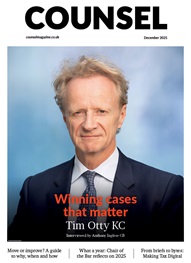*/
Adrian Eissa and Ruth Barber
ISBN: 978 1 84766 707 6. September 2011
Publisher: Bloomsbury Professional. Price: £75
Even barristers of the very near future will look back with astonishment that their predecessors were still, in the 21st century, laden with kilos of textbooks as they set off for court in the morning. Any exceptionally diligent criminal practitioner embarking for a confiscation hearing faces the Herculean prospect of dragging Archbold 2012 with supplement and Mitchell, Taylor and Talbot on Confiscation and Proceeds of Crime behind them. Punishment not just for the muscles but also for the bank balance with RRPs of £455 and £342 respectively.
Of course the advent of e-Archbold is upon us but until the judiciary can be persuaded to follow suit and overcome their atavistic need to have a blunt object to hand so that in extremis they can literally throw the book at vexatious advocates, the prudent barrister will continue to have wood pulp and print by his side.
Justification for these eye watering prices will become increasingly untenable when the publishers’ printing costs are reduced effectively to zero. Until that day arrives a gap in the market exists and it is that gap which Bloomsbury Professional has sought to exploit with the publication of this book RRP £75.
Nobody, least of all the authors, would suggest that this is a title that aspires to go to toe to toe with Mitchell, Taylor and Talbot. Ostensibly, in fact, the target market for the book is not the seasoned Bar at all but instead caseworkers, legal executives and relative new comers to confiscation law. It is a slim volume and the bulk of the book is comprised of the appendices the lengthiest of which is the Proceeds of Crime Act 2002.
As a primer in confiscation law there is no doubt that this book serves a purpose and in a straightforward confiscation hearing it would serve as a relatively cheap supplement to Archbold. However printing off the Act itself would be even cheaper and in a case of any real complexity this book may not yield the necessary in depth case analysis. As ever, you pays your money and you takes your choice.
Max Hardy, 9 Bedford Row
Of course the advent of e-Archbold is upon us but until the judiciary can be persuaded to follow suit and overcome their atavistic need to have a blunt object to hand so that in extremis they can literally throw the book at vexatious advocates, the prudent barrister will continue to have wood pulp and print by his side.
Justification for these eye watering prices will become increasingly untenable when the publishers’ printing costs are reduced effectively to zero. Until that day arrives a gap in the market exists and it is that gap which Bloomsbury Professional has sought to exploit with the publication of this book RRP £75.
Nobody, least of all the authors, would suggest that this is a title that aspires to go to toe to toe with Mitchell, Taylor and Talbot. Ostensibly, in fact, the target market for the book is not the seasoned Bar at all but instead caseworkers, legal executives and relative new comers to confiscation law. It is a slim volume and the bulk of the book is comprised of the appendices the lengthiest of which is the Proceeds of Crime Act 2002.
As a primer in confiscation law there is no doubt that this book serves a purpose and in a straightforward confiscation hearing it would serve as a relatively cheap supplement to Archbold. However printing off the Act itself would be even cheaper and in a case of any real complexity this book may not yield the necessary in depth case analysis. As ever, you pays your money and you takes your choice.
Max Hardy, 9 Bedford Row
Adrian Eissa and Ruth Barber
ISBN: 978 1 84766 707 6. September 2011
Publisher: Bloomsbury Professional. Price: £75
Even barristers of the very near future will look back with astonishment that their predecessors were still, in the 21st century, laden with kilos of textbooks as they set off for court in the morning. Any exceptionally diligent criminal practitioner embarking for a confiscation hearing faces the Herculean prospect of dragging Archbold 2012 with supplement and Mitchell, Taylor and Talbot on Confiscation and Proceeds of Crime behind them. Punishment not just for the muscles but also for the bank balance with RRPs of £455 and £342 respectively.


Chair of the Bar reflects on 2025
Q&A with criminal barrister Nick Murphy, who moved to New Park Court Chambers on the North Eastern Circuit in search of a better work-life balance
Revolt Cycling in Holborn, London’s first sustainable fitness studio, invites barristers to join the revolution – turning pedal power into clean energy
Rachel Davenport, Co-founder and Director at AlphaBiolabs, reflects on how the company’s Giving Back ethos continues to make a difference to communities across the UK
By Marie Law, Director of Toxicology at AlphaBiolabs
AlphaBiolabs has made a £500 donation to Sean’s Place, a men’s mental health charity based in Sefton, as part of its ongoing Giving Back initiative
Professor Dominic Regan and Seán Jones KC present their best buys for this holiday season
Little has changed since Burns v Burns . Cohabiting couples deserve better than to be left on the blasted heath with the existing witch’s brew for another four decades, argues Christopher Stirling
Six months of court observation at the Old Bailey: APPEAL’s Dr Nisha Waller and Tehreem Sultan report their findings on prosecution practices under joint enterprise
Despite its prevalence, autism spectrum disorder remains poorly understood in the criminal justice system. Does Alex Henry’s joint enterprise conviction expose the need to audit prisons? asks Dr Felicity Gerry KC
With automation now deeply embedded in the Department for Work Pensions, Alexander McColl and Alexa Thompson review what we know, what we don’t and avenues for legal challenge